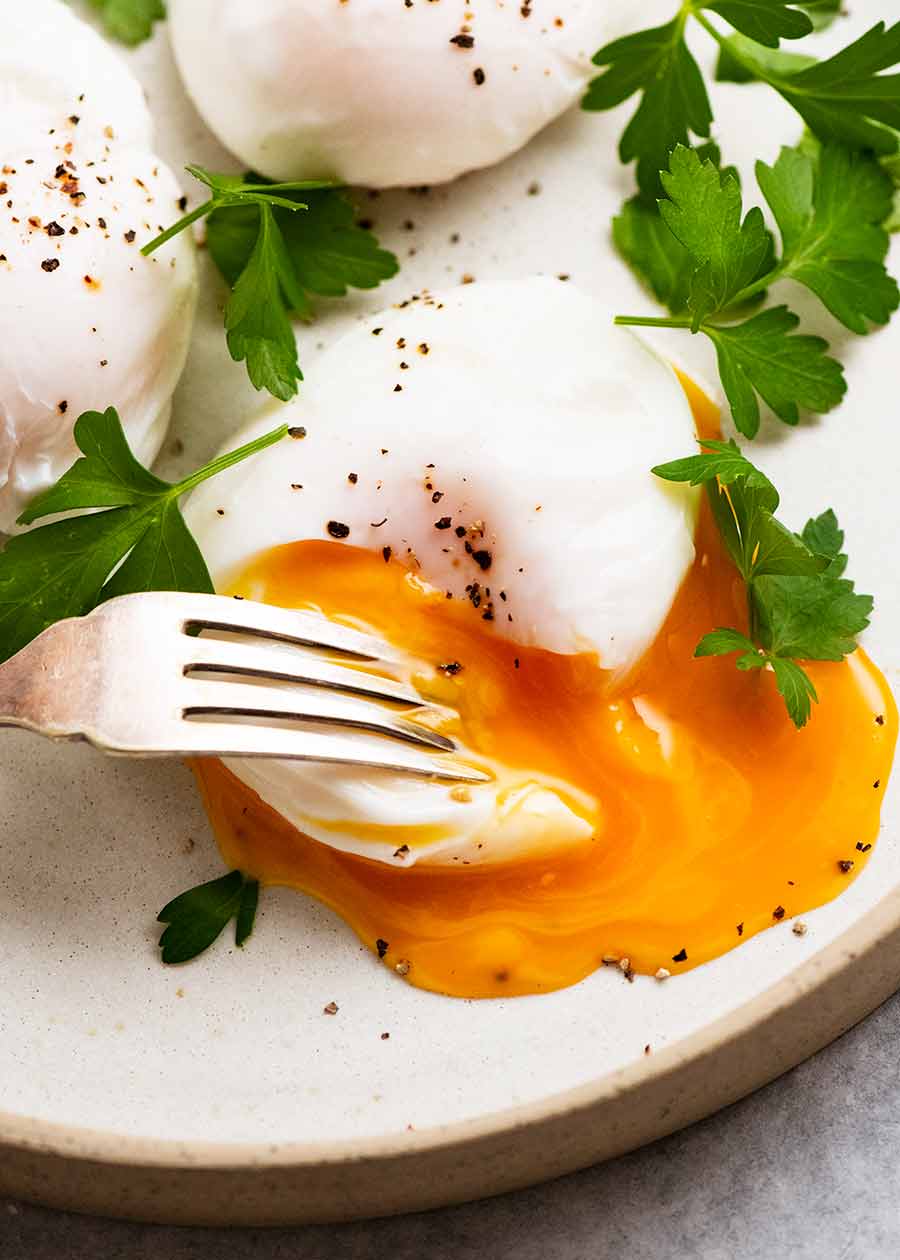
I make poached eggs two ways – an easy “drop and roll” method to make multiple poached eggs in one batch. And the classic “whirlpool” method when I’m just making for myself.
TWO BIG TIPS: strain your eggs to discard the watery whites that create a mess in your pot, and use fridge cold eggs which have better structure than room temp eggs. Sunday Eggs Benedict, here we come!

Heads up: this is quite a long post that contains information for those of you who have always struggled with poached eggs and wondered why. So if you’re not into details and just want to know how to make perfect poached eggs, jump to the recipe or recipe video!
Biggest game-changer: Always strain your eggs
The single biggest tip that will change your poached eggs life is to strain the eggs to get rid of the watery whites that creates a mess in the water.
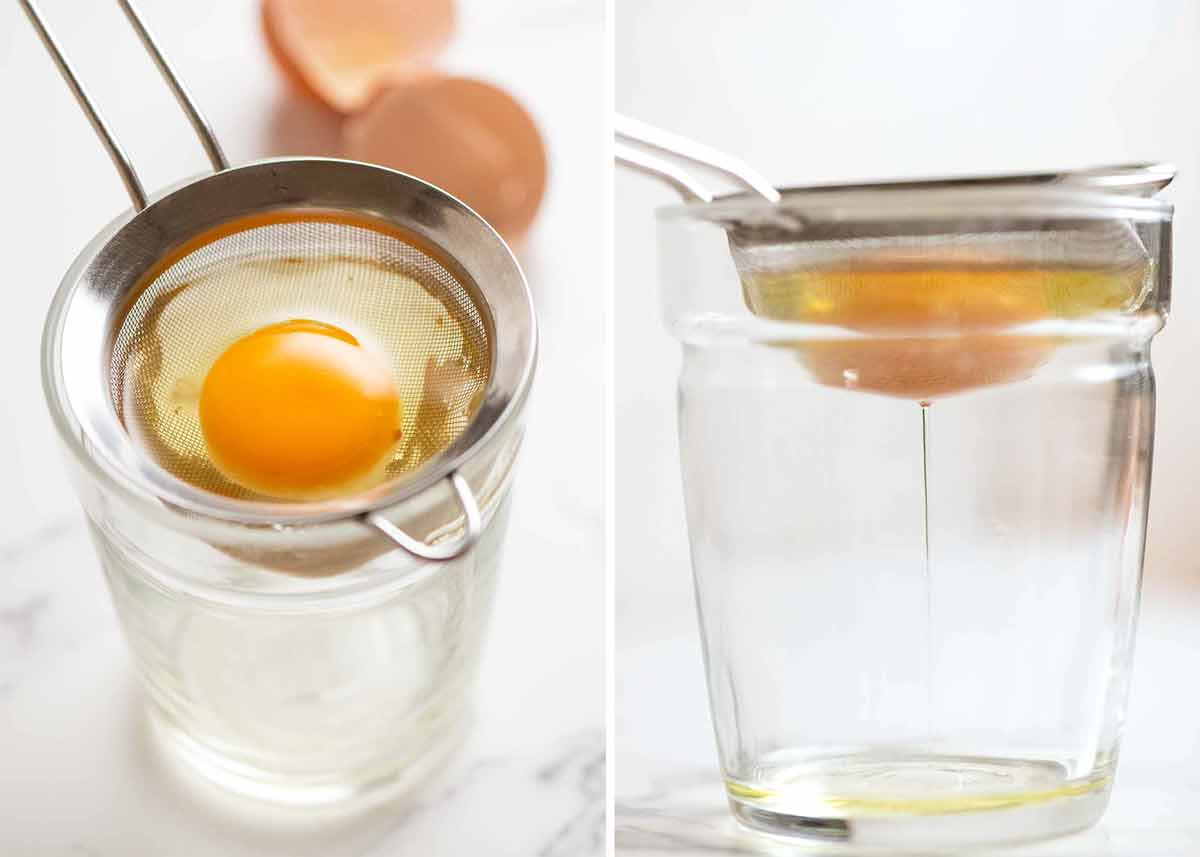
The reason this is necessary is because the egg whites start to break down the moment the chicken lays an egg. Fresh eggs have tight “jelly-like” whites so you can literally crack them into hot water and you’ll pull out a perfect poached egg, no tricks required.
In old eggs (~4 days+), the egg whites break down and become watery which is what creates the frustrating white wisps that cloud your water and ruin the look of your finished egg.
Most of us however don’t have the luxury of access to freshly laid eggs (I wish!!) and will have shop-bought eggs that usually have a degree of watery whites. To eliminate this problem, just strain the eggs!
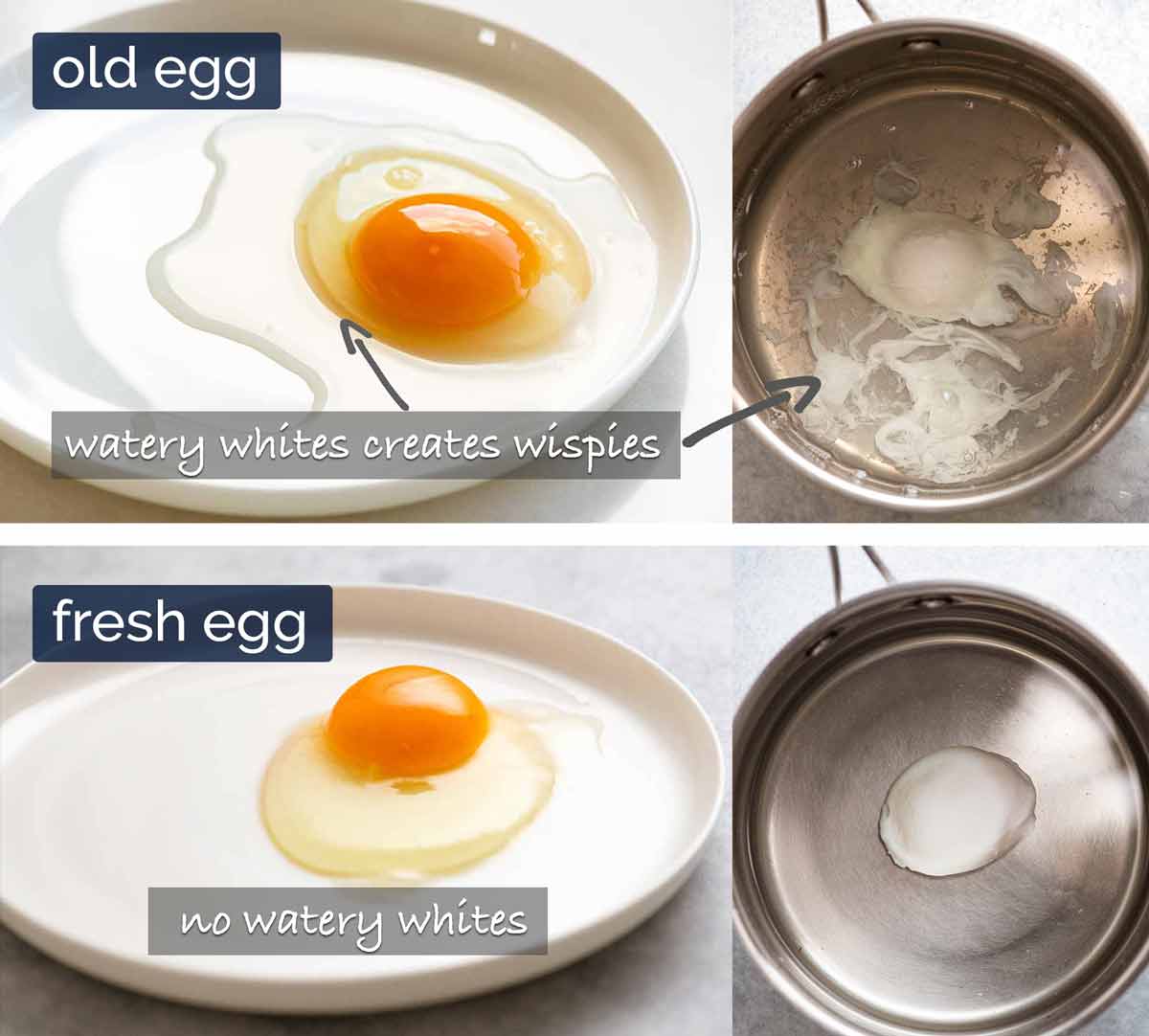
How to tell how fresh your egg is
As mentioned, the fresher the egg, the better. But how can you tell how fresh your egg is before you even crack it? Here’s a quick tip: Simply put the egg in a glass of water and watch how it floats:
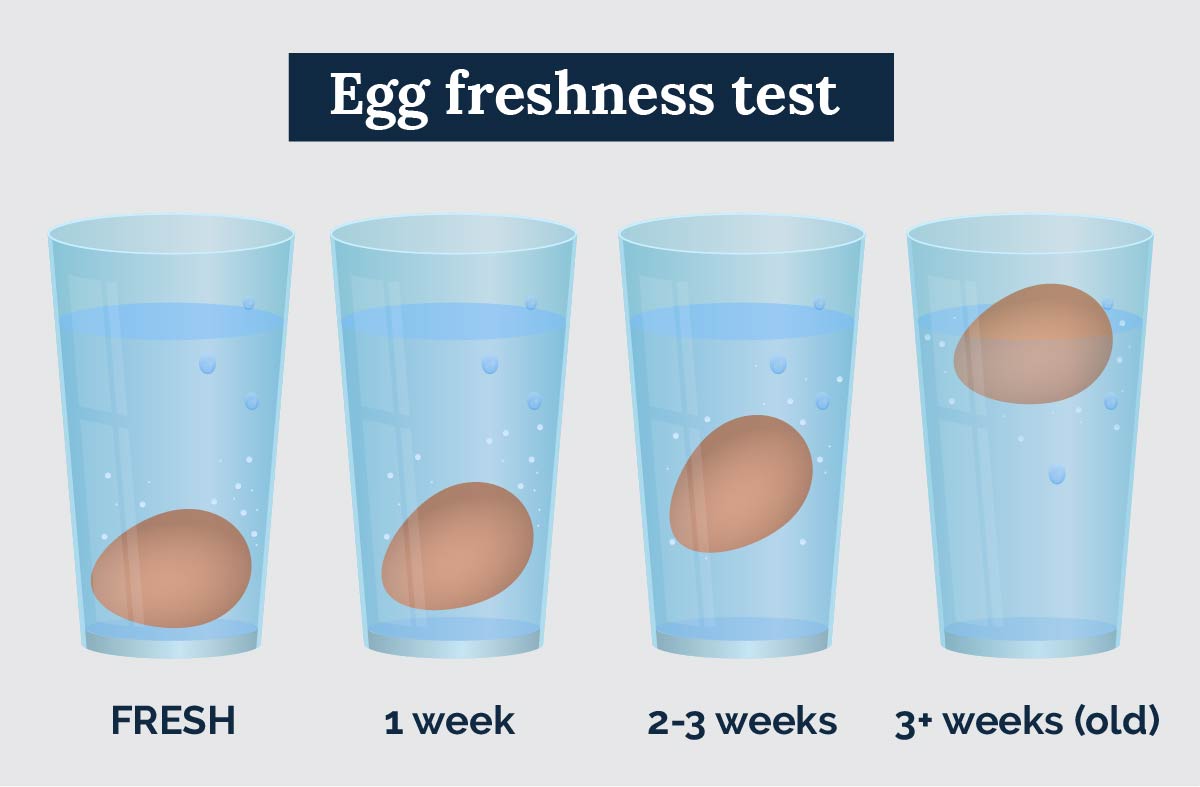
Egg shells are porous and over time an egg will absorb air. Therefore older eggs have more air inside than super-fresh eggs, and will be more buoyant when placed in a glass. 
With the Easy Method, older eggs will end up with more of a fried egg or UFO shape. With the Whirlpool Method, the whites of older eggs won’t wrap around the yolk as well, causing untidy looking poached eggs.
Rule of thumb: If your eggs are 2 weeks old or older stick with the Easy Method to be safe.
Choose a Poaching Method
In today’s recipe, I’m sharing two methods to make poached eggs:
1. Easy Method
My “drop and roll” method. Use this method if you’re new to poaching or if you want to make up to 6 eggs at a time.
2. Whirlpool Method
The traditional method where you stir the water to create a vortex into which the egg is dropped. Use this method if you’re just making one egg for yourself or just want the satisfaction of making poached eggs the way professional chefs do!
Difference between these methods
The difference between these two methods is just shape. The Easy Method tends to sit a bit flatter and sometime comes out a bit “UFO” shaped (the older the egg), whereas if you master the Whirlpool Method, you can make more technical “perfect” poached eggs that sit up high in an oval shape.
Here’s a visual comparison:
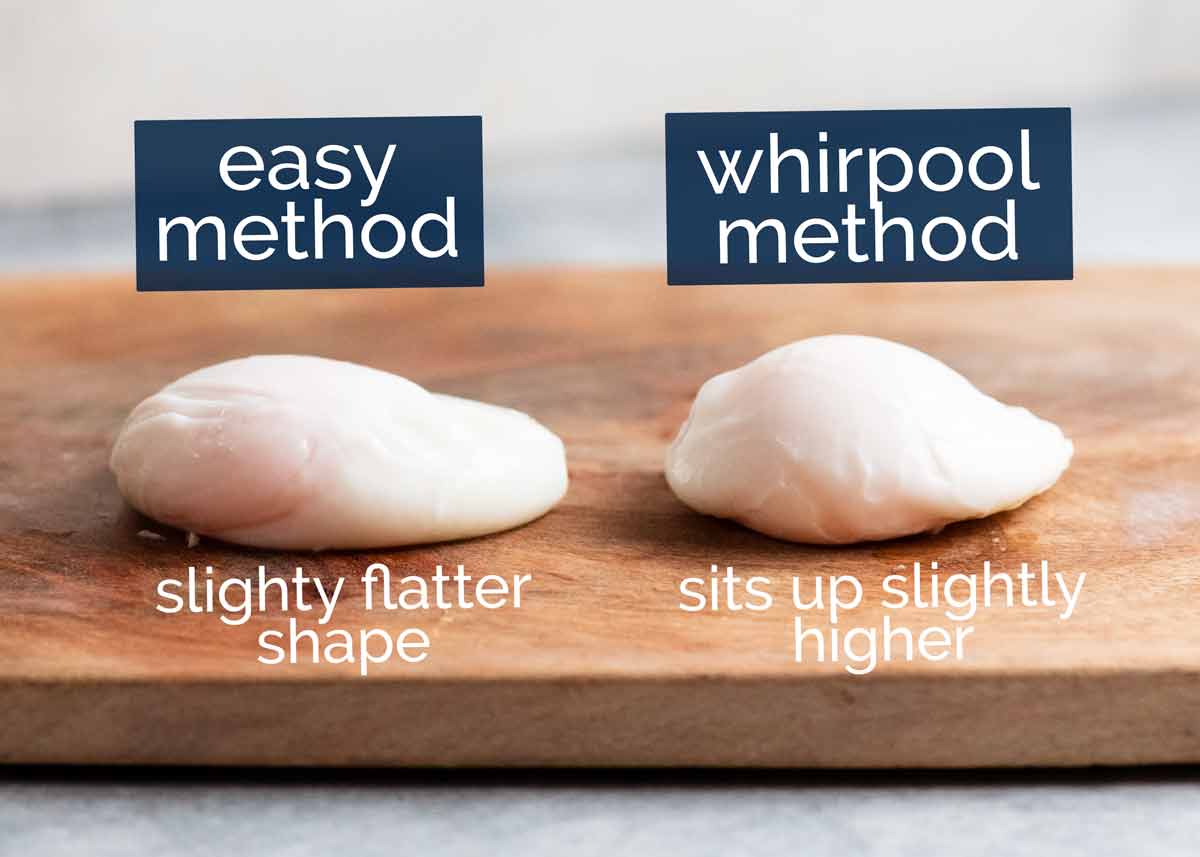
The trade-off is that it’s difficult to make more than one egg at a time with the Whirlpool Method.
Poached Eggs – EASY METHOD
In this method, eggs are carefully rolled out into hot water using teacups, then turned to form the poached egg shape. Rolling the eggs into the water and turning before they are full set is what gives them the poached egg shape, rather than looking like fried eggs. They also cook evenly this way.
Use this method if:
- you want to make up to 6 poached eggs at a time;
- your eggs are two weeks old, or older (use the diagram above to determine age); or
- you are new to poached eggs and just want a simple method that works.
1. Strain Eggs
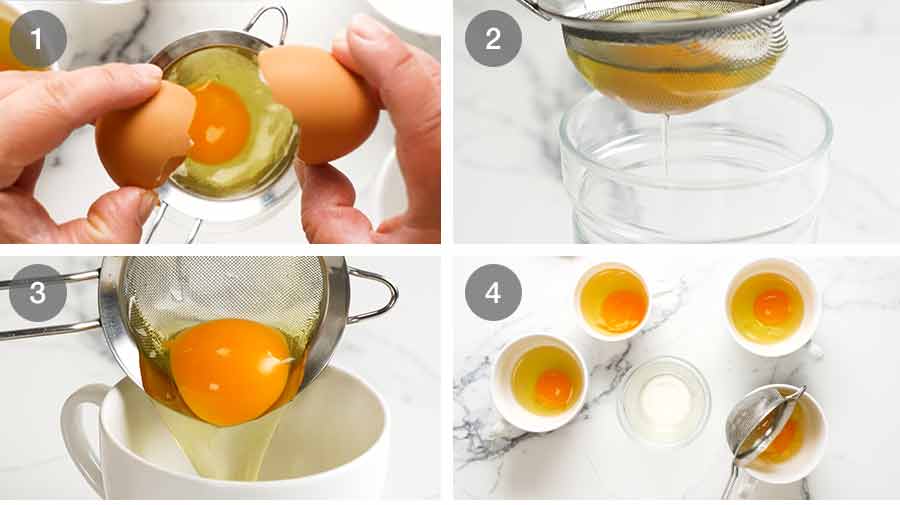
- Strain – crack a fridge cold egg in a strainer. Fridge cold eggs are tighter so hold their shape better for poaching;
- Drain – Leave it for 30 seconds to drain out watery whites. The watery whites cause the wispy whites and for very old eggs, will make a total mess in your water;
- Teacup – Tip the egg into a teacup. Easier to handle than a bowl, and allows you to submerge the cup into the hot water;
- Repeat for as many eggs are you plan to make in one batch, one egg per teacup. Until you become experienced, I recommend sticking with one or two, then progress up to 6 (you will need a large pot so the eggs don’t stick to each other).
2. Right water temperature

- Fill a pot with 10 cm / 4″ of water, then bring it to a boil over high heat. Deep enough to roll the eggs, not too deep so the egg has too far to go before it settles on the base during which time it can lose form and become a disintegrated mess; and
- Then lower the heat until you see small bubbles coming off the surface, but no bubbles breaking the surface of the water. The surface can be quivering a tiny bit, but you don’t want it rippling. Rapid bubble = jiggling eggs = frightful mess!
3. Poaching the eggs (easy method)
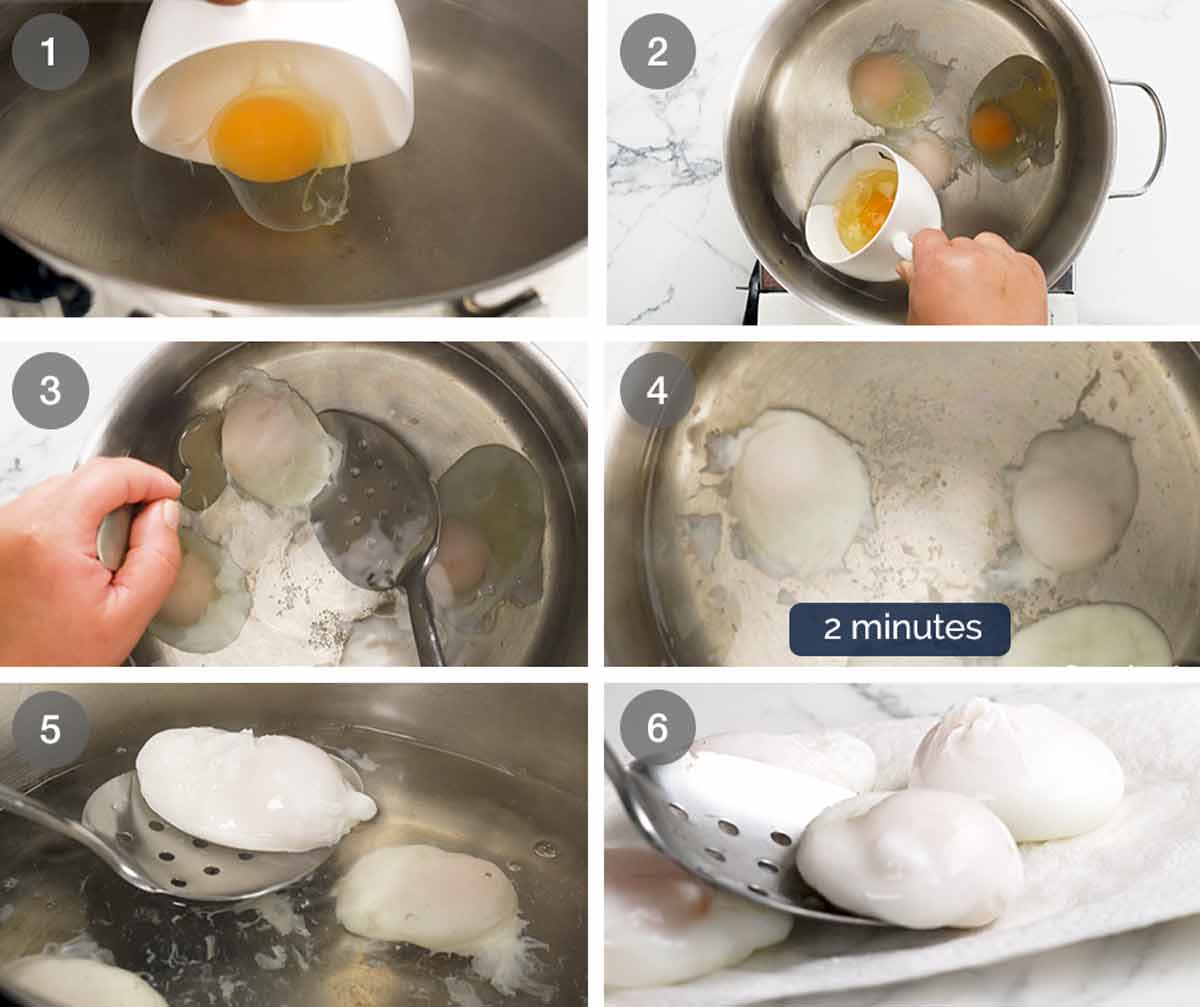
- Submerge & roll out egg – Submerge a teacup into the water then once you touch the base of the pot, tilt the teacup so the egg gently rolls out onto the base of the pot. KEY TIP: minimise the “drop” height from the teacup to the base of the pot for a better shape and less wispy whites. Be gentle but move swiftly because if you hold the teacup suspended in the water for too long, the egg will start to cook the teacup and will get stuck!
- Repeat with remaining eggs, but don’t take longer than 15 seconds at most (ie. if you can only do 4 in this time, so be it – see below for multi-batch poaching);
- Rotate & shape: 20 seconds after the first egg has gone in, the egg will still not be fully set but set enough so you can turn the egg upside down gently to shape it into a poached egg shape. Use both a slotted spoon and a dessert spoon to carefully flip it, starting with the first egg and finishing with the last egg;
- Cook 2 minutes – leave eggs to cook for 1 1/2 minutes for just cooked whites and runny yolks. Optional – rotate one more time at around the 1 minute mark to improve the poached egg shape;
- Remove – check for doneness by lifting one out with a slotted spoon, and gently probing the yolks and whites. Look for set whites but runny yolk – or cook to your liking!
- Drain excess water – When cooked, remove with a slotted spoon, then place on paper towels to remove excess water. The heat will dry the surface within 10 seconds or so, otherwise pat it dry gently. TIP: Do not leave on paper towel for much longer than 1 minute, it may dry out too much and stick. Move to a plate after this time and pat surface dry further if required.
Serve immediately while hot! See below for large batch poached eggs.
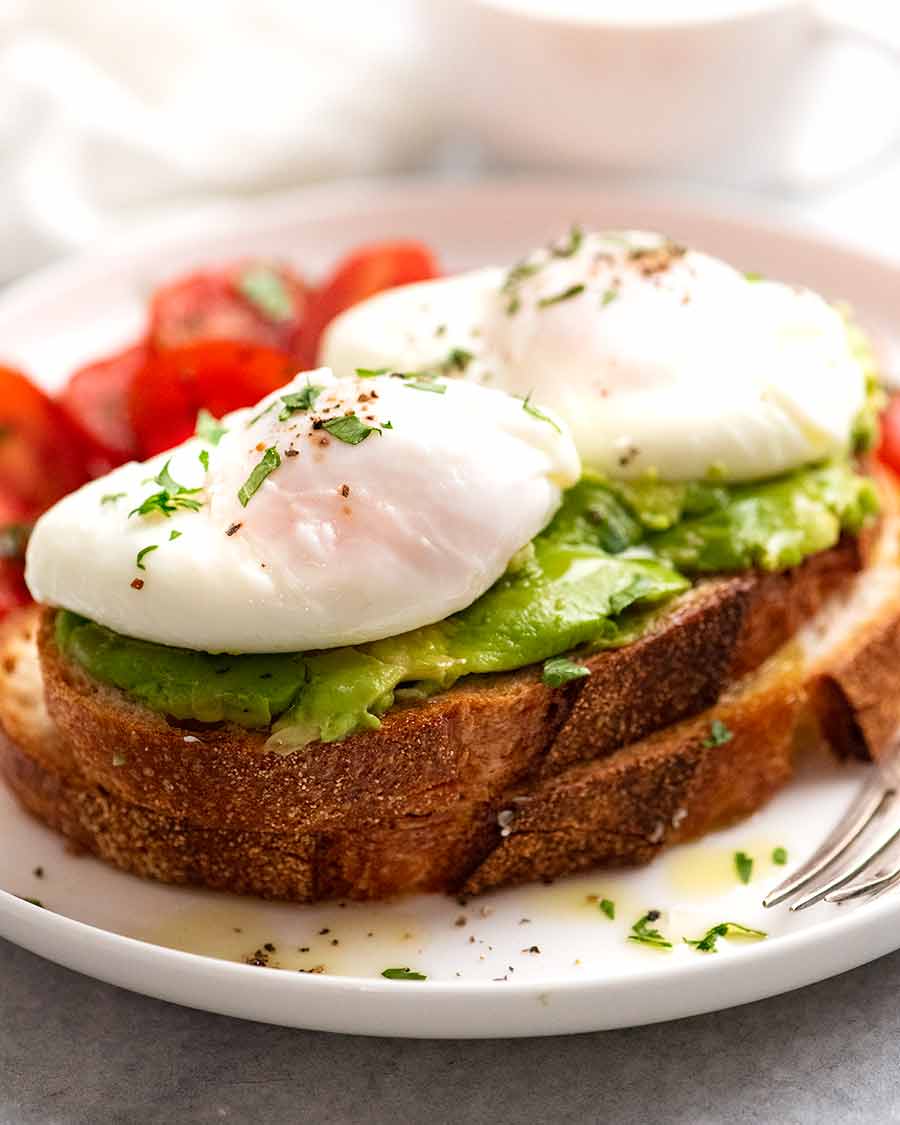
Why the Easy Poached Eggs Method works
For those of you who are interested, here is an explanation for specific directions in the Easy Method. If you’re not – just Jump to the Recipe or skip down to the classic Whirlpool Method section. (Or, to Dozer!)
1. Fresh eggs and straining watery whites
I’ve already covered these two key points at the top of the post so I’ll just recap briefly:
- Fresh eggs are better for nicely shaped poached eggs with lots of egg whites;
- See diagram at the top to tell how fresh your eggs are;
- When buying at the grocery store, choose the carton with the longest shelf date and be sure to strain them. Do this whether using the Whirlpool Method of the Easy Poached Eggs Method; and
- If your eggs are 3 weeks or older, you can still poach them successfully but you’ll find that you lose a LOT of the egg whites when you strain them!

2. Use teacups to gently roll eggs into the water = better shape

The height the egg falls will also affect the success of your poached eggs. If it has a long way to drop before it settles and/or starts to set, then the whites will splay everywhere and create a mess.
So I use teacups so you can submerge it in the water then gently roll eggs out onto the base of the pot. Also, the ability to roll the egg out of the teacup helps with shape, essentially taking the place of the motion of the water in the Whirlpool Method (covered below).
It’s also much easier to hold than a small bowl (says the girl who has accidentally dropped multiple bowls of eggs into hot water!).
The teacup tip applies whether you’re using the Whirlpool Method OR my Easy Poached Eggs method – though with the Whirlpool Method, the teacup must not be submerged in the water because it breaks the whirlpool motion.
3. Fridge-cold eggs
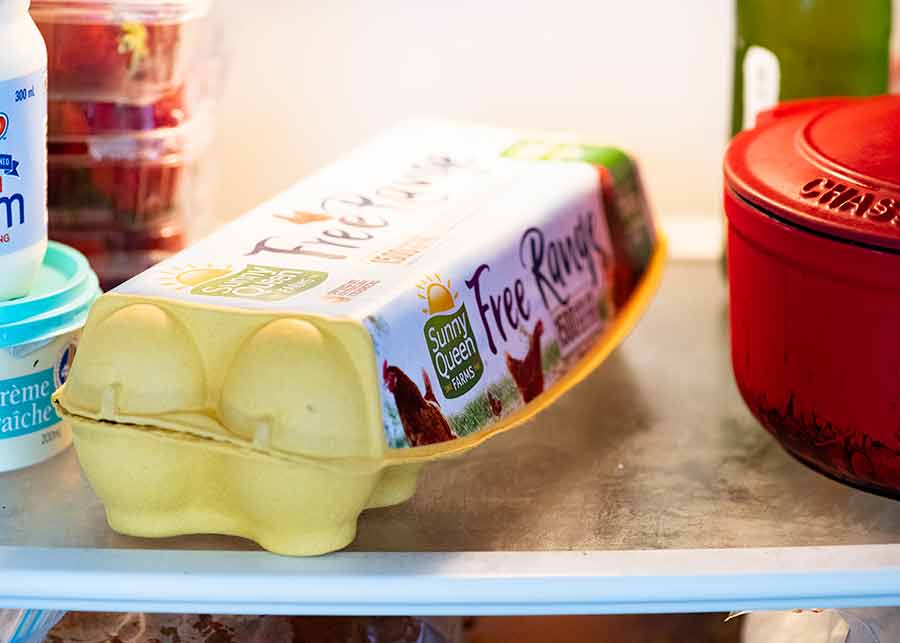
Fridge-cold eggs have tighter whites than room temperature eggs which is why they are easier to separate when cold, but they whip up better into a stiff foam for things like Pavlova when they are at room temperature.
Hence, using fridge-cold eggs helps the poached egg keep its shape rather than disintegrating into a mess when dropped into the water. It also partially compensates for not having fresh eggs because it partially simulates “tighter” whites.
Also, having a cold yolk helps it stay runny until the egg whites are fully set. 
Use of fridge-cold eggs applies to the Whirlpool Method too.
4. Bring to boil, THEN lower heat

The right water temperature is key to poached egg success.
Water not hot enough = eggs dissolve into water before they set = murky pot of milky water.
Boiling too rapidly = egg jiggles around too much and causes the whites to disintegrate.
The best way round this – bring to boil, then turn it down so there’s no bubbles breaking the surface but there’s little bubbles coming up from the base of the pot, then immediately drop eggs in.
This same water heating method applies to the Whirlpool Method too.
5. Vinegar – yes or no?
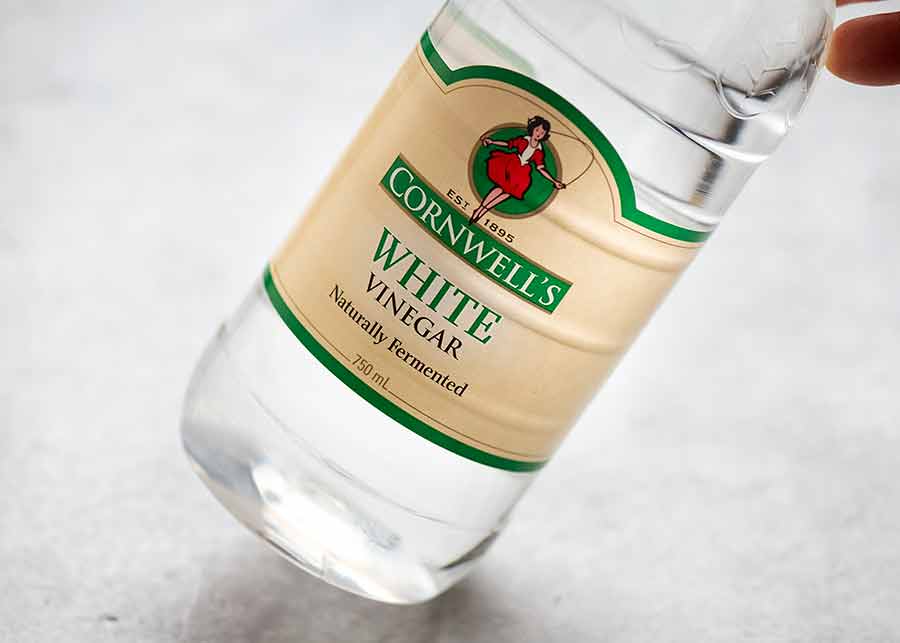
Having tried side by side poached eggs with and without vinegar, I’ve observed that vinegar does seem to make a marginal difference to help keep the whites together ie less risk of wisps.
As for vinegar flavour, it actually takes quite a lot of vinegar to make the poached eggs taste vinegary. With just 1 to 2 tablespoons, it won’t absorb into the egg itself – but you will taste it if you don’t drain the egg before serving!
Conclusion: use 1 – 2 tablespoons of white vinegar if you can’t break the habit or it makes you feel better to have a little extra insurance policy. I rarely bother.
6. Salted water – Yes? No?

I say no. Two theories underpin this idea of salting the water:
- Theory #1: “It seasons the eggs while they poach”. My findings: You need a ton of salt to make a difference because it’s not cooking for that long. If you add enough for the eggs to absorb it, this will actually make the whites harder
- Theory #2: “Salt water increases buoyancy, helping to keep eggs elevated off the base for a ‘better’ poached eggs shape”. My findings: Firstly, this is completely irrelevant with the Easy Method because the egg settles on the base of the pot and it’s the rotation that forms the poached egg shape. For the Whirlpool Method, I observed zero difference using 1/4 cup of salt (which is a LOT!) so my assumption is that you’d need a ton of salt for this to actually make a difference. The speed of the vortex you create has far more of an impact on egg elevation.
7. Drain eggs before serving
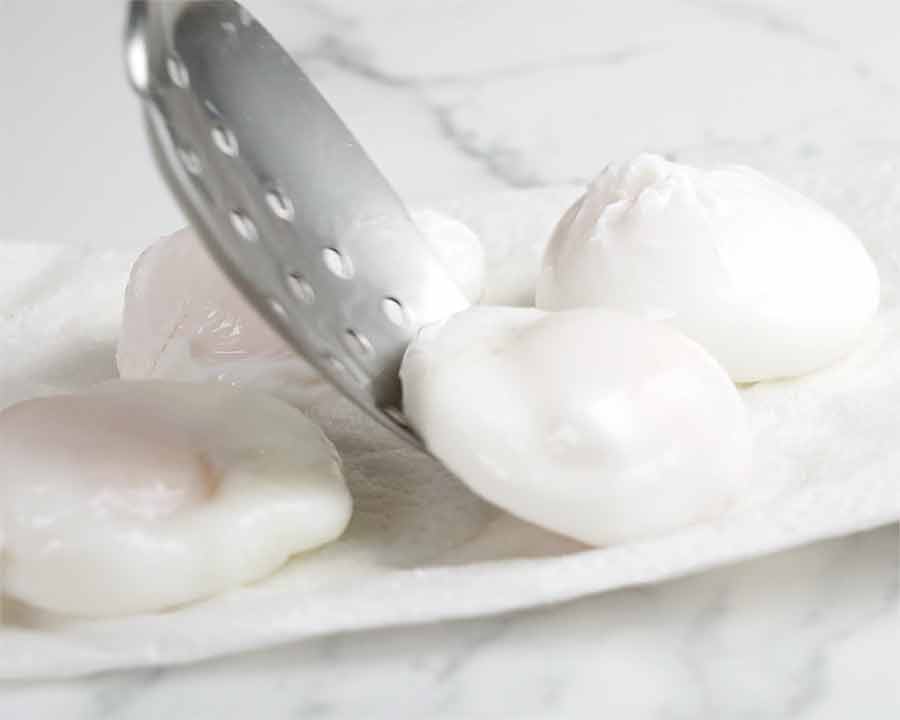
There is nothing worse than a watery poached egg placed served on toast. Nobody wants poaching water soaking into their bread!!!
So always drain the egg on paper towels or a clean tea towel before serving. Leave it for at least 10 seconds so the residual heat steams the surface dry. After a minute, take them off the paper towel (or they’ll tend to stick!) and move them to a plate.
Alrighty! Easy Method explained, now onto the Classic Whirlpool method – or skip to the recipe, recipe video or Dozer  !
!
About the Classic Whirlpool Method
This is the classic method whereby water is swirled into a vortex before dropping an egg into the centre. The motion of the water makes the egg wrap around itself as it sets, forming that perfect poached egg shape.
This method does take practice, and it’s imperative that you either use < 3-day old freshly laid eggs or strain the egg whites very well.
General note:
Just for your own interest, many (most??) cafes and bistros nowadays DO NOT use this method because it simply takes too long to make them. When you’re experienced, you can make two or three at a time by adding extra eggs after the first one has set and creating a new vortex for each egg. But it takes practice! I am not there yet, I keep destroying one of the eggs. 
How to poach eggs using the Whirlpool Method
Use this method if:
- You’re making just one egg for yourself in a small(ish) saucepan;
- Are really determined to try to achieve a “perfect” oval shaped poached egg; or
- Want to feel a sense of accomplishment by making poached eggs the classic way.
DO NOT use this method if your eggs are 2 weeks old or older (see diagram at top of page to determine age of your eggs). The structure of old eggs is not good enough to withstand this method of cooking. Use the Easy Method.
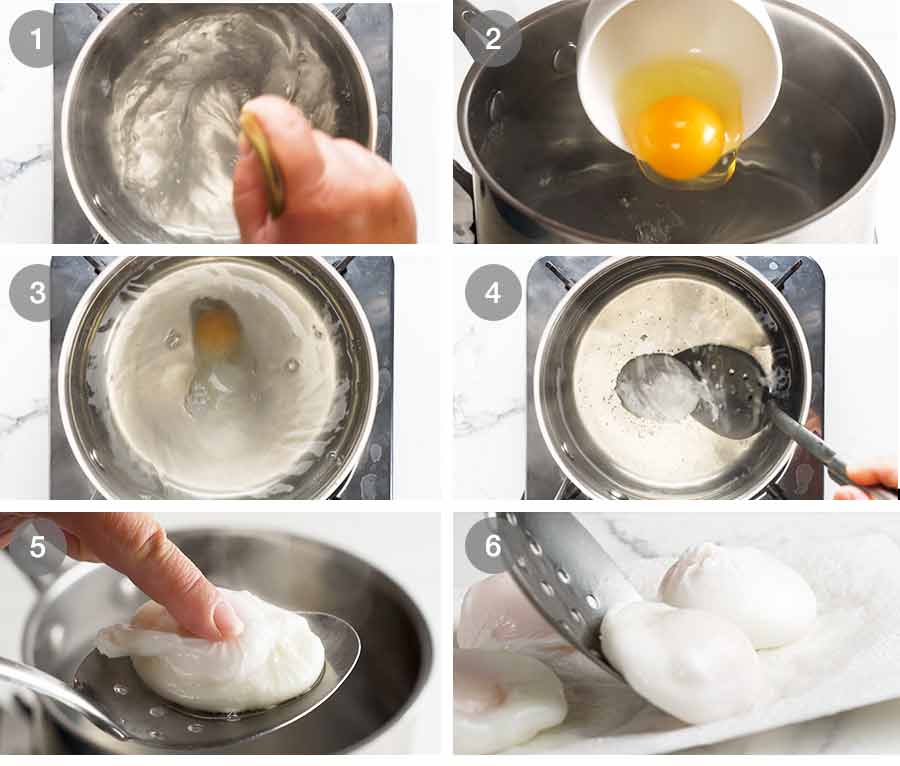
Firstly, strain and place eggs in the teacup, as described above for the Easy Method. Also bring the water to a boil then lower heat, as described above.
- 7 second whirlpool test – Using the handle of a wooden spoon or a dessert spoon, stir the water using a fast motion in a 7 cm / 3″ circle for about 10 seconds so that when you stop stirring, you get a vortex (“V” shape whirlpool in the water) for around 7 seconds before the water surface levels out (although still spinning). If it’s too fast (eg whirlpool lasts for 10 seconds or longer) and the water temperature is a little bit too low, the egg might spin so fast that the yolk separates from the whites! Yep, been there, done that!

- Drop egg into middle of vortex – use teacup to careful drop an egg into the vortex. Bring the teacup to as close to the water surface as you can, but ensure the lip of the teacup does not touch the water because it will break the spinning motion. Slide the egg in swiftly – if you tip it in too slowly, then the part that’s in the water will start spinning and set before the rest of the egg (this can cause the egg to form in a “comet” shape with the yolk at one end and a white tail at the other end);
- Leave to spin – leave the egg alone in the vortex as it slows and eventually stops spinning naturally;
- Cook for 1 1/2 minutes to 2 minutes, depending on how you like your eggs. Lift with slotted spoon and poke to check; and
- Drain on paper towels or clean tea towel before serving. KEY TIP: Do not leave on paper towel for over 1 minute otherwise it may stick a bit. Move it onto a plate.
The thing about the Whirlpool Method is that you can make poached eggs with the “perfect” poached egg shape – like a football without the pointy ends, like this:
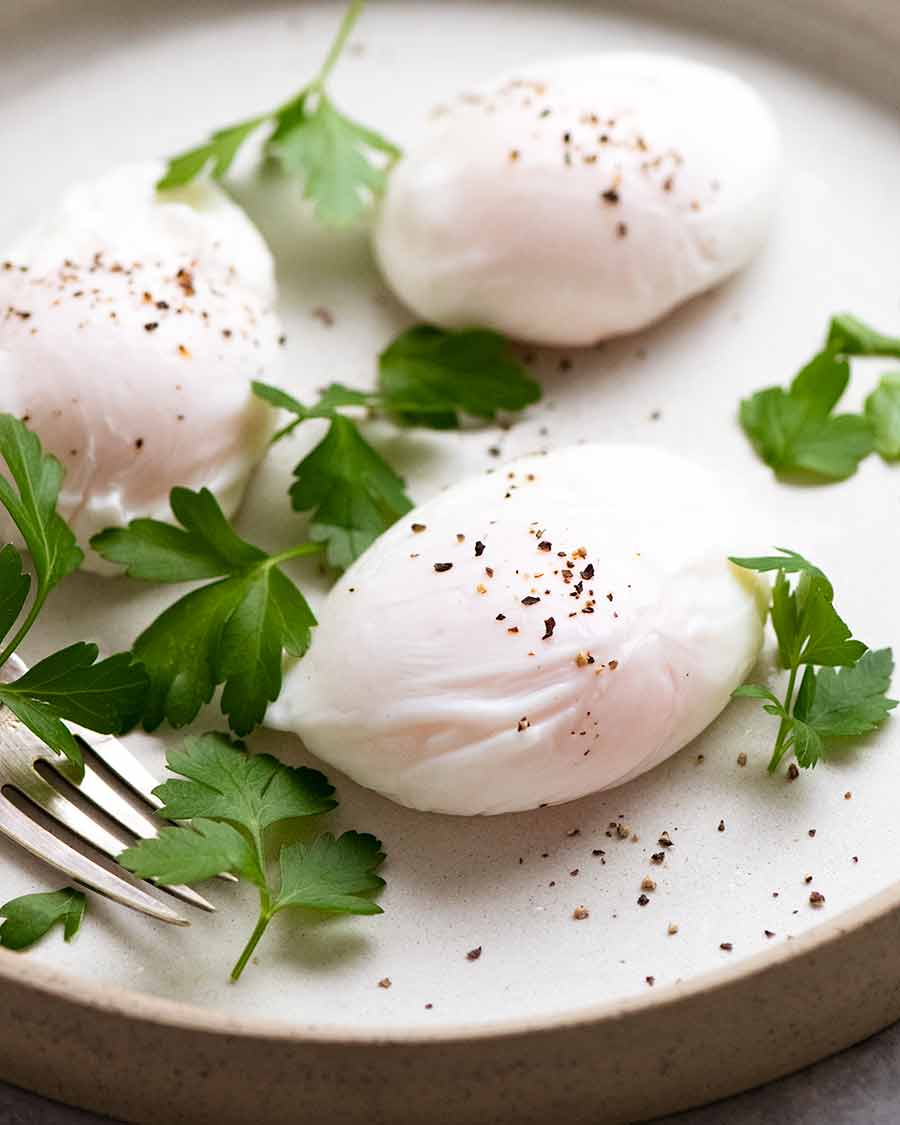
Batch eggs: How to poach lots of eggs!
To poach and serve loads of poached eggs, , just cook poached eggs using one of the above methods. Once cooked, simply slide them into a bowl of cold water. This will stop them from cooking further and keep them fresh until you’re ready to reheat. Cooked eggs are so dense, they do not absorb any of the water.
This is how bistros and cafe prepare for busy weekend brunch service.
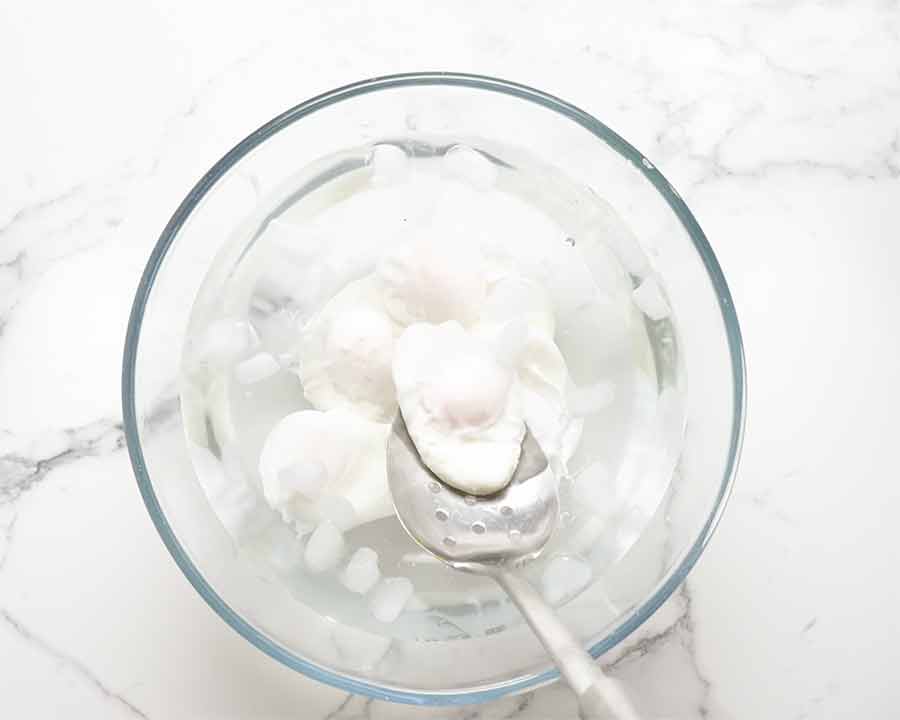
If you’re making loads and loads, add ice to the water to keep the temperature down to help them cool. But if you’re only making 6 to 8 eggs, then just cold tap water will be sufficient.
These eggs can stay like that for 2 days in an airtight container in the fridge.
To reheat, bring a pot of water to the boil, then turn the heat off. Then take 6 to 8 eggs out of the icy water using a slotted spoon, and lower into the pot. Leave for 30 seconds, then remove and drain on paper towels. In this short cook time, because they are start icy cold, the eggs won’t cook any further but just heat through – including the runny yolk.
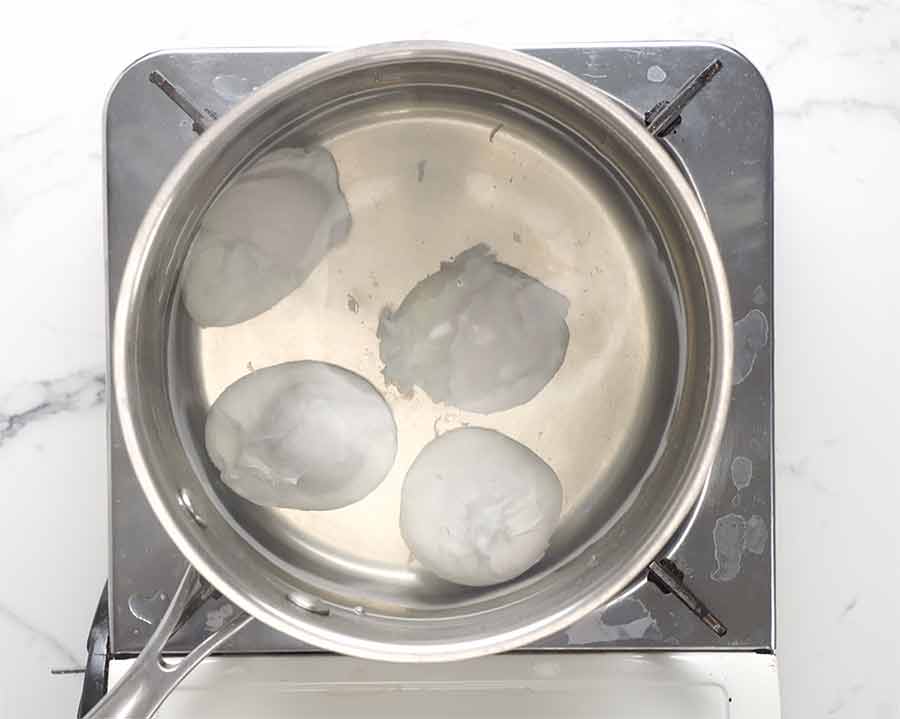
How to store poached eggs
Cooked poached eggs can be stored in water in an airtight container for up to 2 days in the fridge, then reheated per the above. Eggs are quite dense so they won’t absorb water within 2 days, but I have found that beyond this the yolks do get a bit watery.
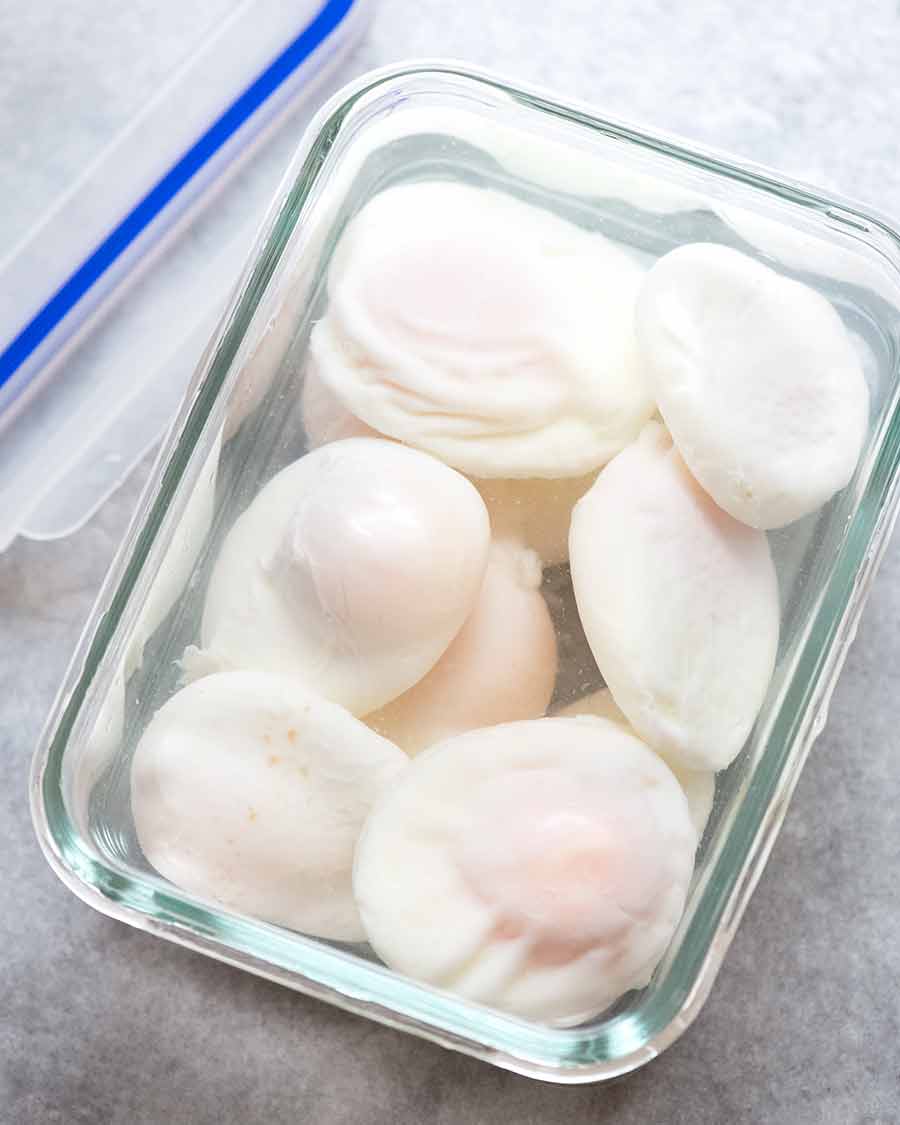
How to serve poached eggs
Here are some ideas for how to enjoy your perfectly poached eggs that you’ve just made without any stress at all, nailing every single one perfectly because you followed my tips and tricks!!
- On toast – plain is just delicious, but with avocado it’s extra great! Make it extra special by making your own Crusty Artisan Bread – super easy, no kneading required.
- Eggs Benedict – on English muffins or other bread of choice, topped with a ham, bacon or smoked salmon, a poached egg then Hollandaise Sauce. See recipe here (psst – I use a super easy Hollandaise Sauce method AND it can be reheated!);
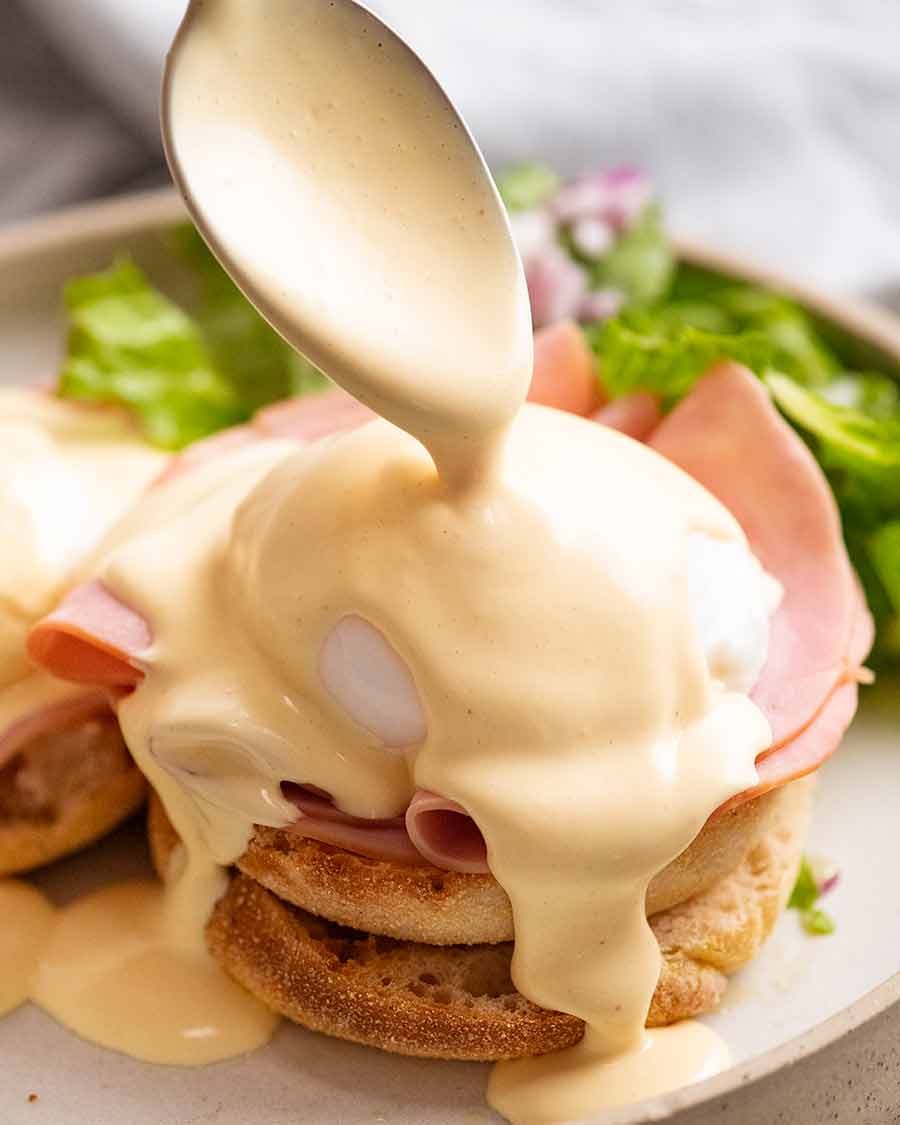
- Over asparagus – another classic way to serve poached eggs. Take it over the top with Hollandaise sauce!
- On fried rice – this is a terrific way to take any fried rice recipe and add an extra hit of protein plus “sauce” from the runny yolk to turn it into a meal!
- On Caesar salad – add a classy twist to Caesar salad by leaving out the boiled eggs and topping each serving with a poached egg instead;
- On stewed or baked beans – eggs and beans are best mates. Try my homemade Heinz Baked Beans or Southern Baked Beans with Bacon piled over toast, with a poached egg on top for an extra-decadent touch.
And with that, you are now officially armed with everything you need for your new perfect (and dare I say, EASY!) poached egg life. Go forth and enjoy! – Nagi x
Watch how to make it
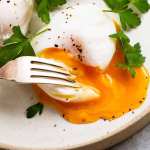
Poached Eggs
Ingredients
- 1 - 6 eggs , fridge cold (Note 1)
Optional:
- 2 tbsp white vinegar or cider vinegar - Whirlpool method only (Note 2)
Instructions
Strain Eggs (do this first for either Method)
-
Crack an egg into a small strainer set over a bowl or glass. Leave for 30 seconds and jiggle around a bit so watery whites strain through.
-
Carefully transfer to a teacup. Repeat for as many eggs as you plan to make in one batch (Whirlpool max 2, Easy Method up to 6), one in each teacup.
Boil water then reduce heat
-
For both methods, bring water to the boil over high heat, then turn the heat down so there are tiny bubbles from the base of the pot but big bubbles are not breaking water surface. (Note 4)
Easy Method (good to make 4 to 6 eggs):
-
Fill a pot with 7.5 cm / 3" water. (Note 3) Bring to boil then lower heat, per above directions.
-
Submerge a teacup into the water so you can gently roll the egg out onto the base of the pot - minimise the drop distance for neatest shape.
-
Repeat with more eggs, but don't take longer than 15 seconds to put them all in.
-
20 seconds after the first egg has gone in, eggs should be starting to but are not fully set. Use a slotted spoon and tablespoon/dessert spoon to gently turn the eggs upside down - start with the first egg that went in, end with the last.
-
Leave for 1 minute, then turn again.
-
Leave for another 30 seconds then using a slotted spoon, lift one out to check for doneness - whites should be soft but set, yolks should be runny.
-
Drain & serve: Transfer to paper towel to drain and for top to dry with residual heat - 15 seconds. (Don't leave for too long or it can get stuck to the paper towel.) Serve! See below for ideas.
Whirlpool Method:
-
Fill a large saucepan or small pot with 7.5 cm / 3" of water. Add vinegar, if using (I don't). Bring to boil then lower heat, per above directions.
-
Using the handle of a flat-handled wooden spoon, stir the water quickly (10cm/4" diameter circle) to create a whirlpool so the vortex ("V" shape in water) stays for 7 seconds. (Note 5)
-
Carefully slip the egg into the middle of the vortex, with the teacup as close to the water as possible but do NOT touch the water - it will break the water motion.
-
The spinning water will make the whites wrap around itself so it forms a lovely poached egg shape once it stops spinning (~ 15 seconds).
-
Leave for 1 1/2 to 2 minutes - after 30 seconds, you can rotate once or twice, or swirl water again if you want to do it for you.
-
Using a slotted spoon, lift out to check for doneness - whites should be soft but set, yolks should be runny.
-
Drain & serve: Transfer to paper towel to drain and for top to dry with residual heat - 15 seconds. (Don't leave for too long or it can get stuck to the paper towel.) Serve!
-
Multiple eggs: Use 15 cm / 6" of water. Once the first egg has set (~ 30 sec), swirl water again and drop in another. I've seen experts do 4 eggs. I prefer the Easy Method!
Large batch poached eggs
-
Store in cold water - Use either method above, and place cooked eggs in a large bowl of cold tap water which stops the eggs cooking further. If making a lot, use ice water to ensure water temperature stays down
-
To reheat: Bring a large pot of water to the boil, then turn heat down to low. Transfer eggs straight from cold water into hot water, leave 30 seconds - they will not cook in this time, but will just reheat. Drain on paper towels, then serve!
Serving:
-
Serve on toast, perhaps smeared with avocado, on asparagus or make Eggs Benedict! Great also on homemade baked beans and even a Caesar salad!
Notes
Whirlpool method - large saucepan or small pot. Don't use a large pot - the vortex can be so fast, the egg will spin too quickly and the yolk might separate from the whites! 4. Water temp - bring to boil first to get enough heat in it, then reduce heat. If water is bubbling/moving too much = eggs jiggle = mess. If not hot enough = eggs mix into water instead of setting. Tiny bubbles coming up from base of pot is ok, but do not have big bubbles breaking surface. Surface can be barely quivering, but not rippling.
After heat is turned down, drop eggs in immediately before water temp drops. 5. Vortex - if you create a very fast vortex, the egg can spin so fast that the centrifugal force makes the yolk separates from the whites!! This is especially a problem with old grocery store eggs. My test is the "7 second rule" - as long as there is even a slight vortex ("V" in the centre of the swirl) for 7 seconds after retracting the stirring tool, it is spinning fast enough. If it goes for 12 seconds or longer, it's too fast. If less than 4 seconds, too slow. 6. Storage - Poached eggs can be stored submerged in water for up to 2 days in the fridge in an airtight container or covered bowl. Reheat per above. Do not store for longer - eggs are a bit porous so will start to absorb water, making yolks a bit runny. Not suitable for freezing. 7. Nutrition for 1 large egg (55g/2oz each).
Life of Dozer
October pin up boy! (That’s a homemade doggie biscuit on his head  )
)
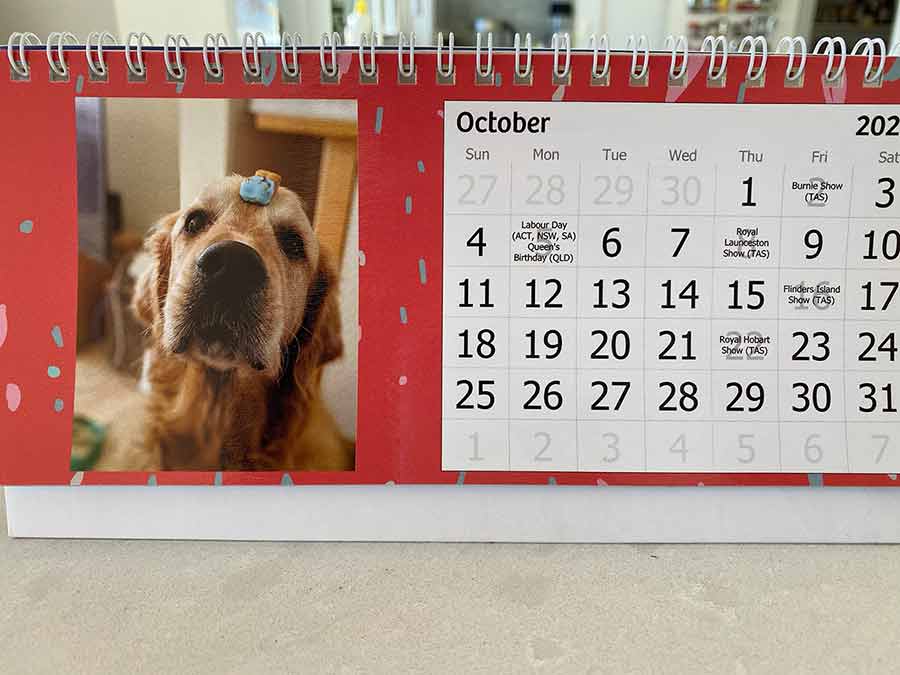
The post Poached Eggs appeared first on RecipeTin Eats.
from RecipeTin Eats https://ift.tt/2IchvNr
via IFTTT





No comments:
Post a Comment